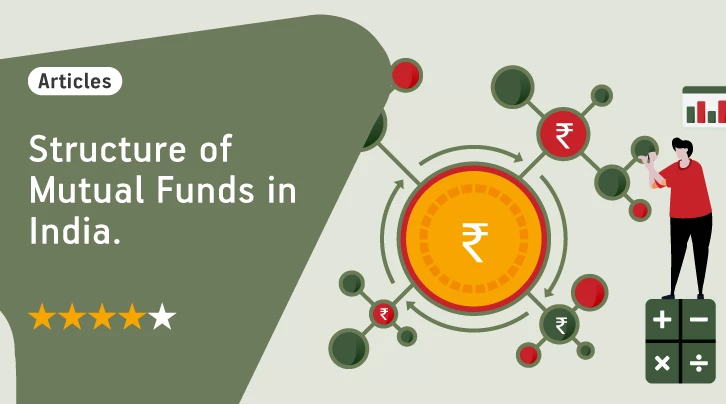A mutual fund operates on a three-tiered structure, commencing with the establishment of a trust that comprises a sponsor, trustees, and an AMC (Asset Management Company). The sponsor acts as a promoter, akin to that of a company. The trustees, integral to the trust, hold the mutual fund's assets on behalf of the unit holders, under the approval and oversight of SEBI (Securities and Exchange Board of India).
To begin, a mutual fund collects funds from various investors, which are then invested in securities according to the predefined objectives of the fund. The returns or benefits earned from these investments are subsequently distributed to each investor after deducting expenses by the AMC. Let’s take a look at the structure of mutual funds in a detailed manner.
Structure Of Mutual Funds
The mutual fund operates within a three-tiered structure, consisting of the sponsor, trustees, and AMC. All mutual funds are established as trusts under "The Indian Trust Act, 1882," and their activities are governed by the "SEBI (Mutual Funds) Regulations 1996." Among the three entities, the trustees play the most critical role, followed by the sponsor, who initiates the fund, and the AMC, who assumes the role of the investment manager.
Here’s a detailed instruction of the mutual fund structure:
Tier 1: Fund Sponsor
In the three-tier mutual fund structure in India, the fund sponsor occupies the first layer. A sponsor can be an individual or entity with the authority to establish a mutual fund, aiming to generate income through fund management. This fund management may be executed through an associate company responsible for handling the fund's investments. Moreover, the sponsor can act as a promoter for the associate company.
To establish a mutual fund, the sponsor must seek approval from SEBI. However, the sponsor cannot operate independently; it must create a Public Trust under the Indian Trust Act, 1882, and subsequently register it with SEBI. As the primary entity driving the promotion of the mutual fund company and overseeing public funds, the sponsor plays a crucial role in the entire process.
Tier 2: Trust and Trustees
The second layer in the structure of Mutual Funds in India consists of the Trust and the trustees. The trustees, also known as the protectors of the fund, are typically appointed by the fund sponsor. As the name suggests, they play a crucial role in upholding investors' trust and monitoring the fund's growth. A trust is established by the fund sponsor in favour of the trustees through a document called a trust deed. The trustees manage the trust and are accountable to the investors, serving as the primary guardians of the fund and its assets.
Tier 3: Asset Management Companies (AMCs)
The Asset Management Company (AMC) or the Fund Management Firm serves as the operational investment manager of the trust, but it must first undergo registration with the Government of India.
The roles of AMCs encompass various responsibilities, such as introducing and initiating mutual fund schemes. They collaborate with founders and trustees to oversee the progress of these schemes. Additionally, AMCs are tasked with managing funds and engaging associate services from brokers, registrars, bankers, lawyers, and other relevant entities.
Other Participants in The Structure of Mutual Funds
The other participants in the structure of mutual funds in India are as follows:
Custodian
A Custodian is an entity entrusted with the secure storage of securities. These Custodians are registered with SEBI and hold the responsibility for facilitating the transfer and delivery of units and securities. Additionally, they play a crucial role in helping investors update their holdings at specific intervals and keep track of their investments. Apart from their primary task of safekeeping, Custodians also manage the collection of corporate benefits, including bonus issues, interest, dividends, and other related matters.
Registrar And Transfer Agent
RTAs (Registrar and Transfer Agents) serve as intermediaries connecting Fund Managers and Investors. These SEBI-registered entities are responsible for handling various tasks, including processing mutual fund applications, assisting with investor KYC (Know Your Customer), managing and providing periodic investment statements or reports, updating investor records, and processing investor requests.
Auditor
The auditor verifies AMC records to ensure proper use of collected funds and certifies the absence of fraud. The AMC can choose its auditor and determine their compensation, but it must adhere to appointment rules, publish the auditor's report, and fulfil other obligations under the Companies Act.
Broker
Brokers, authorised by SEBI and licensed to manage trading accounts, act as intermediaries connecting investors to the stock market. AMCs rely on brokers to execute trades, and some brokers also provide research reports that AMCs use for due diligence purposes.
Intermediaries
The intermediary can be anyone, such as agents, bankers, distributors, and more. They play a role as a bridge connecting retail investors and AMCs. These intermediaries recommend mutual funds to investors and receive commissions from the AMC as compensation. They shall be registered intermediaries only.
Summing up
The structure of mutual funds in India is well-defined, with checks and balances for investors' safety. However, as an investor, due diligence is crucial. Not all mutual fund schemes are the same, so study past performance, fees, and the fund manager's track record. If needed, open an account with a reputable broker offering educational resources for investors. Making informed decisions is vital to effectively build wealth through mutual fund investments.
Mutual Fund investments are subject to market risks, read all scheme related documents carefully.





 1800-270-7000
1800-270-7000




